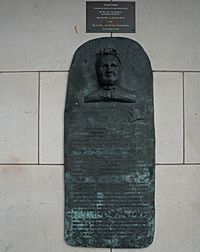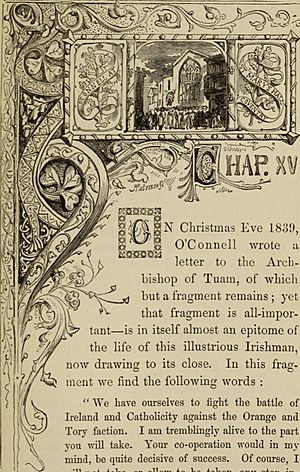Margaret Anna Cusack facts for kids
Quick facts for kids
Margaret Anna Cusack
|
|
|---|---|

Memorial to Margret Anna Cusack in Dublin
|
|
| Born | 6 May 1829 Mercer Street/York Street, Dublin, Ireland
|
| Died | 5 June 1899 (aged 70) Leamington Spa, England, UK
|
| Other names | Sister Mary Francis Cusack Mother Margaret |
| Occupation | Foundress of Sisters of St. Joseph of Peace religious congregation |
Margaret Anna Cusack (born 6 May 1829 in Dublin, Ireland – died 5 June 1899) was a remarkable woman known by many names, including Sister Mary Francis Cusack and Mother Margaret. She was a nun who changed her religious path several times, starting as an Anglican nun, then becoming a Roman Catholic nun, and later founding a new group of religious sisters called the Sisters of St. Joseph of Peace. She eventually returned to the Anglican faith.
Margaret Cusack was a very independent and sometimes controversial person. She was a strong supporter of Irish rights and often disagreed with church leaders. By 1870, over 200,000 copies of her books had been sold worldwide. The money she earned from these books helped victims of the Famine of 1879 and fed the poor.
Contents
Early Life and Religious Journey

Margaret Anna Cusack was born in Coolock, County Dublin, Ireland. Her family belonged to the Church of Ireland, which is an Anglican church. Her parents were Samuel and Sara Stoney Cusack. Her father was a doctor. When Margaret was a teenager, her parents separated. She, her mother, and her brother Samuel moved to Exeter, England, where Margaret attended boarding school.
Becoming the "Nun of Kenmare"
In 1852, after her fiancé, Charles Holmes, sadly passed away, Margaret joined a convent of Anglican nuns. She was influenced by the Oxford Movement, a group within the Anglican Church that wanted to bring back older Christian traditions.
In 1858, she decided to become a Roman Catholic and joined the Poor Clares in Newry, Ireland. The Poor Clares were Franciscan nuns who taught poor girls. Margaret took the name Sister Francis Clare. In 1861, she moved with a small group of nuns to Kenmare, County Kerry, a very poor part of Ireland, to start a new Poor Clare convent.
Margaret became known as the "Nun of Kenmare." She wrote 35 books, including popular religious stories, poems, and books about Irish history. She started her own publishing company, Kenmare Publications, and sold over 200,000 copies of her books in less than ten years. She used the money to help people in need.
During the famine of 1871, she raised and gave out about £15,000 to help people. She spoke out strongly against landlords who treated their tenants unfairly, especially Lord Lansdowne. She was a passionate Irish nationalist and wrote The Patriot's History of Ireland in 1869. In 1872, she published The Liberator: His Life and Times, about the famous Irish leader Daniel O'Connell. After writing a book about the mistreatment of tenants, she received threats and left her convent in Kenmare in 1881.
The Knock Apparition
Margaret Cusack was a strong believer in the apparition of the Virgin Mary at Knock, County Mayo, in 1879. She moved to Mayo, hoping to build a convent there. She was known for being very determined and sometimes disagreed with church leaders.
In 1880, she published a booklet called The Apparition at Knock, which included statements from the people who saw the vision. This helped to spread the story of Knock. Later, in 1936, another investigation was held to look into the events at Knock.
In 1995, important documents were found among Margaret Cusack's papers. These documents included the original statements from the witnesses of the apparition and other letters about cures. This discovery helped historians learn more about the early days of Knock.
Margaret Cusack, along with others, helped make Knock a famous place for Marian pilgrimages (religious journeys). The Knock pilgrimages and the Land League (a movement for land rights in Ireland) grew at the same time. Many people involved in both movements worked together to promote them.
Founding the Sisters of St. Joseph of Peace
Margaret Cusack had some disagreements with the local priest and archbishop. She wanted to start a training school for young Irish women who planned to move to America. She believed these women needed job skills to succeed. The Archbishop of Tuam supported the idea of a training school but didn't want to encourage emigration. However, Margaret convinced him that people would emigrate anyway, so it was better to prepare them.
The archbishop allowed her to start a convent at Knock. But Margaret wanted to create a new religious group called the Sisters of St. Joseph of Peace, while the archbishop wanted her to establish a Poor Clare community. Margaret became impatient with the archbishop and left Knock in 1883. She took many records about the apparitions and funds meant for the new convent, which caused some problems. She then left the Poor Clares and went to England.
In 1884, Margaret met with Pope Leo XIII and received his permission to leave the Poor Clares and start her new group. The Sisters of St. Joseph of Peace were founded to create and care for homes for girls who needed help. They would teach these girls useful skills like domestic service and good habits.
She opened the first house for her new order in Nottingham, England. In 1885, she opened another house in Jersey City, New Jersey, which was the first Sisters of St. Joseph of Peace foundation in the United States. She also opened a hostel for Irish immigrant girls in Englewood Cliffs, New Jersey. Her popular books, like Lives of Irish Saints and Illustrated History of Ireland, helped fund her convents. As of As of 2014[update], the Sisters of St. Joseph of Peace have communities in Great Britain, Canada, Haiti, Ireland, and the USA.
Later Life and Writings
In America, Margaret Cusack again faced disagreements with local Catholic leaders. This time, it was about funding and her public support for a priest who had been suspended. She wrote a booklet defending this priest, Edward McGlynn, who supported the economic ideas of Henry George. These ideas were popular with workers and Irish nationalists but were seen as too radical by some church leaders.
Margaret's involvement in politics caused a lot of discussion. She resigned as the head of her order, and a friend, Honoria Gaffney, became the new leader in 1888.
Margaret Cusack then returned to the Anglican Communion. She wrote her autobiography, The Nun of Kenmare, in 1888. She also gave lectures and wrote several books that were critical of the Catholic Church, including The Black Pope: History of the Jesuits and What Rome Teaches.
Margaret Anna Cusack passed away on 5 June 1899, at the age of 70. She was buried in Leamington Spa, England. For a long time, she was not widely remembered. However, after the Second Vatican Council in the 1960s, religious orders were encouraged to look back at their beginnings and the goals of their founders. Since then, many studies have been done on Margaret Cusack. She is now seen by some as a pioneer for women's rights and a social reformer who was ahead of her time.
Her Important Books
Margaret Cusack was a prolific writer. In 1868, her book An Illustrated History of Ireland was published. In the introduction, she wrote about the unfair treatment of Irish tenants. She believed that many honest people in England didn't truly understand the injustices faced by the Irish.
Her novels include Ned Rusheen, or, Who Fired the First Shot? (1871) and Tim O'Halloran's Choice (1877). In 1872, she wrote Honehurst Rectory, which made fun of Dr. Pusey and the Puseyite order. That same year, all copies of her Life of St. Patrick were destroyed in a fire at her publishing office.
She also wrote Advice to Irish Girls in America (1872), which gave tips for domestic service jobs. In 1874, she wrote Women's Work in Modern Society, encouraging women to be good Christian mothers.
Her book A History of the Irish Nation (1877) was seen as very detailed and learned. In 1878, she published The Trias Thaumaturga; or, Three Wonder-Working Saints of Ireland, which told the stories of Patrick, Columba, and Brigit.
She also wrote poetry, including Cloister Songs and Hymns for Children (1881). In total, she published over fifty works. Some of her most important books include A Student's History of Ireland, Lives of Daniel O'Connell, St. Patrick, St. Columba, and St. Bridget, and her two autobiographies, The Nun of Kenmare (1888) and The Story of My Life (1893).
|


